Yelong Shen
Phi-4-Mini Technical Report: Compact yet Powerful Multimodal Language Models via Mixture-of-LoRAs
Mar 03, 2025Abstract:We introduce Phi-4-Mini and Phi-4-Multimodal, compact yet highly capable language and multimodal models. Phi-4-Mini is a 3.8-billion-parameter language model trained on high-quality web and synthetic data, significantly outperforming recent open-source models of similar size and matching the performance of models twice its size on math and coding tasks requiring complex reasoning. This achievement is driven by a carefully curated synthetic data recipe emphasizing high-quality math and coding datasets. Compared to its predecessor, Phi-3.5-Mini, Phi-4-Mini features an expanded vocabulary size of 200K tokens to better support multilingual applications, as well as group query attention for more efficient long-sequence generation. Phi-4-Multimodal is a multimodal model that integrates text, vision, and speech/audio input modalities into a single model. Its novel modality extension approach leverages LoRA adapters and modality-specific routers to allow multiple inference modes combining various modalities without interference. For example, it now ranks first in the OpenASR leaderboard to date, although the LoRA component of the speech/audio modality has just 460 million parameters. Phi-4-Multimodal supports scenarios involving (vision + language), (vision + speech), and (speech/audio) inputs, outperforming larger vision-language and speech-language models on a wide range of tasks. Additionally, we experiment to further train Phi-4-Mini to enhance its reasoning capabilities. Despite its compact 3.8-billion-parameter size, this experimental version achieves reasoning performance on par with or surpassing significantly larger models, including DeepSeek-R1-Distill-Qwen-7B and DeepSeek-R1-Distill-Llama-8B.
Sigma: Differential Rescaling of Query, Key and Value for Efficient Language Models
Jan 23, 2025



Abstract:We introduce Sigma, an efficient large language model specialized for the system domain, empowered by a novel architecture including DiffQKV attention, and pre-trained on our meticulously collected system domain data. DiffQKV attention significantly enhances the inference efficiency of Sigma by optimizing the Query (Q), Key (K), and Value (V) components in the attention mechanism differentially, based on their varying impacts on the model performance and efficiency indicators. Specifically, we (1) conduct extensive experiments that demonstrate the model's varying sensitivity to the compression of K and V components, leading to the development of differentially compressed KV, and (2) propose augmented Q to expand the Q head dimension, which enhances the model's representation capacity with minimal impacts on the inference speed. Rigorous theoretical and empirical analyses reveal that DiffQKV attention significantly enhances efficiency, achieving up to a 33.36% improvement in inference speed over the conventional grouped-query attention (GQA) in long-context scenarios. We pre-train Sigma on 6T tokens from various sources, including 19.5B system domain data that we carefully collect and 1T tokens of synthesized and rewritten data. In general domains, Sigma achieves comparable performance to other state-of-arts models. In the system domain, we introduce the first comprehensive benchmark AIMicius, where Sigma demonstrates remarkable performance across all tasks, significantly outperforming GPT-4 with an absolute improvement up to 52.5%.
Is Your World Simulator a Good Story Presenter? A Consecutive Events-Based Benchmark for Future Long Video Generation
Dec 17, 2024Abstract:The current state-of-the-art video generative models can produce commercial-grade videos with highly realistic details. However, they still struggle to coherently present multiple sequential events in the stories specified by the prompts, which is foreseeable an essential capability for future long video generation scenarios. For example, top T2V generative models still fail to generate a video of the short simple story 'how to put an elephant into a refrigerator.' While existing detail-oriented benchmarks primarily focus on fine-grained metrics like aesthetic quality and spatial-temporal consistency, they fall short of evaluating models' abilities to handle event-level story presentation. To address this gap, we introduce StoryEval, a story-oriented benchmark specifically designed to assess text-to-video (T2V) models' story-completion capabilities. StoryEval features 423 prompts spanning 7 classes, each representing short stories composed of 2-4 consecutive events. We employ advanced vision-language models, such as GPT-4V and LLaVA-OV-Chat-72B, to verify the completion of each event in the generated videos, applying a unanimous voting method to enhance reliability. Our methods ensure high alignment with human evaluations, and the evaluation of 11 models reveals its challenge, with none exceeding an average story-completion rate of 50%. StoryEval provides a new benchmark for advancing T2V models and highlights the challenges and opportunities in developing next-generation solutions for coherent story-driven video generation.
Mojito: Motion Trajectory and Intensity Control for Video Generation
Dec 12, 2024



Abstract:Recent advancements in diffusion models have shown great promise in producing high-quality video content. However, efficiently training diffusion models capable of integrating directional guidance and controllable motion intensity remains a challenging and under-explored area. This paper introduces Mojito, a diffusion model that incorporates both \textbf{Mo}tion tra\textbf{j}ectory and \textbf{i}ntensi\textbf{t}y contr\textbf{o}l for text to video generation. Specifically, Mojito features a Directional Motion Control module that leverages cross-attention to efficiently direct the generated object's motion without additional training, alongside a Motion Intensity Modulator that uses optical flow maps generated from videos to guide varying levels of motion intensity. Extensive experiments demonstrate Mojito's effectiveness in achieving precise trajectory and intensity control with high computational efficiency, generating motion patterns that closely match specified directions and intensities, providing realistic dynamics that align well with natural motion in real-world scenarios.
StreamAdapter: Efficient Test Time Adaptation from Contextual Streams
Nov 14, 2024



Abstract:In-context learning (ICL) allows large language models (LLMs) to adapt to new tasks directly from the given demonstrations without requiring gradient updates. While recent advances have expanded context windows to accommodate more demonstrations, this approach increases inference costs without necessarily improving performance. To mitigate these issues, We propose StreamAdapter, a novel approach that directly updates model parameters from context at test time, eliminating the need for explicit in-context demonstrations. StreamAdapter employs context mapping and weight absorption mechanisms to dynamically transform ICL demonstrations into parameter updates with minimal additional parameters. By reducing reliance on numerous in-context examples, StreamAdapter significantly reduce inference costs and allows for efficient inference with constant time complexity, regardless of demonstration count. Extensive experiments across diverse tasks and model architectures demonstrate that StreamAdapter achieves comparable or superior adaptation capability to ICL while requiring significantly fewer demonstrations. The superior task adaptation and context encoding capabilities of StreamAdapter on both language understanding and generation tasks provides a new perspective for adapting LLMs at test time using context, allowing for more efficient adaptation across scenarios and more cost-effective inference
MTL-LoRA: Low-Rank Adaptation for Multi-Task Learning
Oct 15, 2024



Abstract:Parameter-efficient fine-tuning (PEFT) has been widely employed for domain adaptation, with LoRA being one of the most prominent methods due to its simplicity and effectiveness. However, in multi-task learning (MTL) scenarios, LoRA tends to obscure the distinction between tasks by projecting sparse high-dimensional features from different tasks into the same dense low-dimensional intrinsic space. This leads to task interference and suboptimal performance for LoRA and its variants. To tackle this challenge, we propose MTL-LoRA, which retains the advantages of low-rank adaptation while significantly enhancing multi-task learning capabilities. MTL-LoRA augments LoRA by incorporating additional task-adaptive parameters that differentiate task-specific information and effectively capture shared knowledge across various tasks within low-dimensional spaces. This approach enables large language models (LLMs) pre-trained on general corpus to adapt to different target task domains with a limited number of trainable parameters. Comprehensive experimental results, including evaluations on public academic benchmarks for natural language understanding, commonsense reasoning, and image-text understanding, as well as real-world industrial text Ads relevance datasets, demonstrate that MTL-LoRA outperforms LoRA and its various variants with comparable or even fewer learnable parameters in multitask learning.
Temperature-Centric Investigation of Speculative Decoding with Knowledge Distillation
Oct 14, 2024Abstract:Speculative decoding stands as a pivotal technique to expedite inference in autoregressive (large) language models. This method employs a smaller draft model to speculate a block of tokens, which the target model then evaluates for acceptance. Despite a wealth of studies aimed at increasing the efficiency of speculative decoding, the influence of generation configurations on the decoding process remains poorly understood, especially concerning decoding temperatures. This paper delves into the effects of decoding temperatures on speculative decoding's efficacy. Beginning with knowledge distillation (KD), we first highlight the challenge of decoding at higher temperatures, and demonstrate KD in a consistent temperature setting could be a remedy. We also investigate the effects of out-of-domain testing sets with out-of-range temperatures. Building upon these findings, we take an initial step to further the speedup for speculative decoding, particularly in a high-temperature generation setting. Our work offers new insights into how generation configurations drastically affect the performance of speculative decoding, and underscores the need for developing methods that focus on diverse decoding configurations. Code is publically available at https://github.com/ozyyshr/TempSpec.
LoRC: Low-Rank Compression for LLMs KV Cache with a Progressive Compression Strategy
Oct 04, 2024



Abstract:The Key-Value (KV) cache is a crucial component in serving transformer-based autoregressive large language models (LLMs), enabling faster inference by storing previously computed KV vectors. However, its memory consumption scales linearly with sequence length and batch size, posing a significant bottleneck in LLM deployment. Existing approaches to mitigate this issue include: (1) efficient attention variants integrated in upcycling stages, which requires extensive parameter tuning thus unsuitable for pre-trained LLMs; (2) KV cache compression at test time, primarily through token eviction policies, which often overlook inter-layer dependencies and can be task-specific. This paper introduces an orthogonal approach to KV cache compression. We propose a low-rank approximation of KV weight matrices, allowing for plug-in integration with existing transformer-based LLMs without model retraining. To effectively compress KV cache at the weight level, we adjust for layerwise sensitivity and introduce a progressive compression strategy, which is supported by our theoretical analysis on how compression errors accumulate in deep networks. Our method is designed to function without model tuning in upcycling stages or task-specific profiling in test stages. Extensive experiments with LLaMA models ranging from 8B to 70B parameters across various tasks show that our approach significantly reduces the GPU memory footprint while maintaining performance.
GRIN: GRadient-INformed MoE
Sep 18, 2024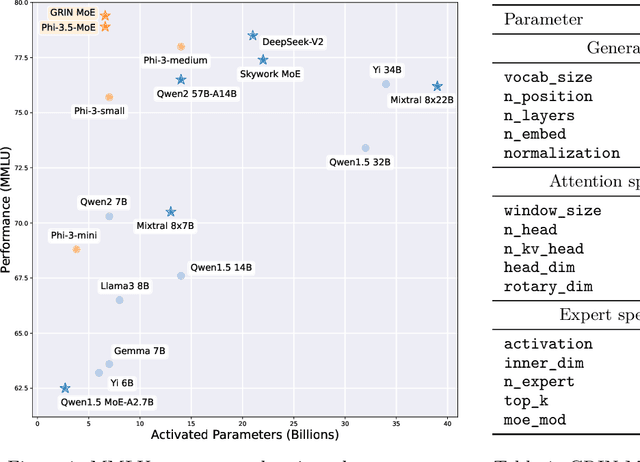
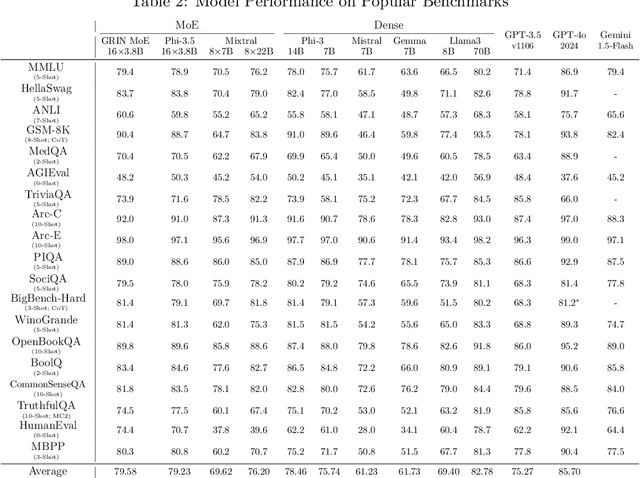
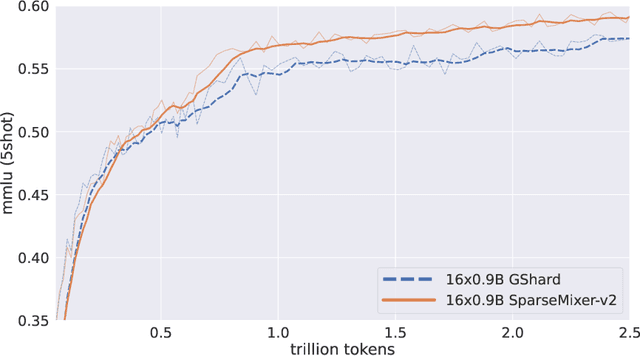

Abstract:Mixture-of-Experts (MoE) models scale more effectively than dense models due to sparse computation through expert routing, selectively activating only a small subset of expert modules. However, sparse computation challenges traditional training practices, as discrete expert routing hinders standard backpropagation and thus gradient-based optimization, which are the cornerstone of deep learning. To better pursue the scaling power of MoE, we introduce GRIN (GRadient-INformed MoE training), which incorporates sparse gradient estimation for expert routing and configures model parallelism to avoid token dropping. Applying GRIN to autoregressive language modeling, we develop a top-2 16$\times$3.8B MoE model. Our model, with only 6.6B activated parameters, outperforms a 7B dense model and matches the performance of a 14B dense model trained on the same data. Extensive evaluations across diverse tasks demonstrate the potential of GRIN to significantly enhance MoE efficacy, achieving 79.4 on MMLU, 83.7 on HellaSwag, 74.4 on HumanEval, and 58.9 on MATH.
Demo: SGCode: A Flexible Prompt-Optimizing System for Secure Generation of Code
Sep 11, 2024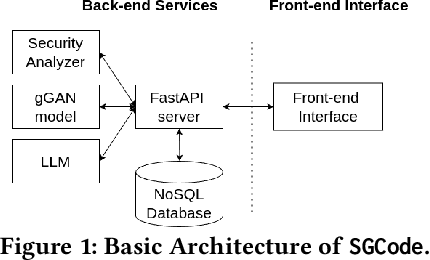

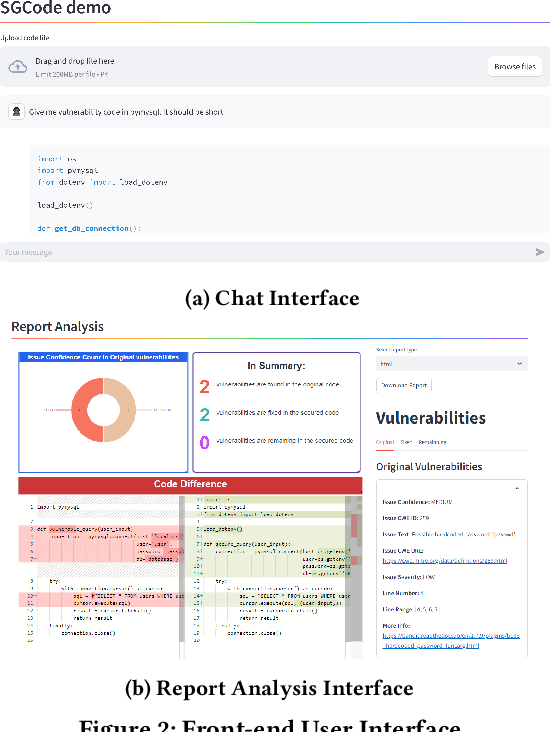
Abstract:This paper introduces SGCode, a flexible prompt-optimizing system to generate secure code with large language models (LLMs). SGCode integrates recent prompt-optimization approaches with LLMs in a unified system accessible through front-end and back-end APIs, enabling users to 1) generate secure code, which is free of vulnerabilities, 2) review and share security analysis, and 3) easily switch from one prompt optimization approach to another, while providing insights on model and system performance. We populated SGCode on an AWS server with PromSec, an approach that optimizes prompts by combining an LLM and security tools with a lightweight generative adversarial graph neural network to detect and fix security vulnerabilities in the generated code. Extensive experiments show that SGCode is practical as a public tool to gain insights into the trade-offs between model utility, secure code generation, and system cost. SGCode has only a marginal cost compared with prompting LLMs. SGCode is available at: http://3.131.141.63:8501/.
 Add to Chrome
Add to Chrome Add to Firefox
Add to Firefox Add to Edge
Add to Edge